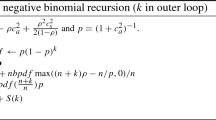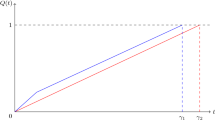Abstract
We consider an M/G/1 queue with symmetric service discipline. The class of symmetric service disciplines contains, in particular, the preemptive last-come-first-served discipline and the processor-sharing discipline. It has been conjectured in Kella et al. [1] that the marginal distribution of the queue length at any time is identical for all symmetric disciplines if the queue starts empty. In this paper we show that this conjecture is true if service requirements have an Erlang distribution. We also show by a counterexample, involving the hyperexponential distribution, that the conjecture is generally not true.
Similar content being viewed by others
References
O. Kella, B. Zwart, and O. Boxma, Some time-dependent properties of symmetric M/G/1 queues. J. Appl. Prob. 42 (2005) 223–234.
F.P. Kelly, Reversibility and Stochastic Networks (John Wiley, Chichester, 1979).
M.Yu. Kitaev, The M/G/1 processor-sharing model: transient behavior. Queueing Systems 14 (1993) 239–273.
Author information
Authors and Affiliations
Corresponding author
Additional information
AMS Subject Classifications Primary—60K25; Secondary—90B22
Rights and permissions
About this article
Cite this article
Denisov, D., Sapozhnikov, A. On the distribution of the number of customers in the symmetric M/G/1 queue. Queueing Syst 54, 237–241 (2006). https://doi.org/10.1007/s11134-006-0298-2
Received:
Revised:
Issue Date:
DOI: https://doi.org/10.1007/s11134-006-0298-2




